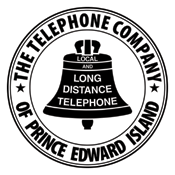 |
This page will show you new items received for the museum, and details the progress of any needed restorations. These items will be left on this page for a couple of weeks after they are received, or after any needed restoration is completed. Not all items received will be shown, but some of the more interesting items will be. |
Many items have been added recently - too many to mention here. I have started a Museum Facebook page you can join to see all new acquisitions. You can join it by going to https://www.facebook.com/groups/PEITelelephoneMuseum/
The largest recent addition is a 1938 Bell Canada LIU Telephone Truck Back found in January in Picton Ontario. It belonged to Gary Batchelor who was clearing out a family home. It had been used to store plumbing parts outside for the past 30 years or so. Brian Gough picked it up in Picton, took it home and stored it over the winter, then brought it to the Island with him a couple of weeks ago.
I have spent the past two weeks repairing it, building a trailer for it so it will be appear similar to the way it would have looked on a late 20s truck, and painting it inside and out. It now displays some of the Museum's tools.
Other recently added items is a Bell System Brace and bit (hand drill), various tools, come-along used to tighten newly installed lines, and other items! |
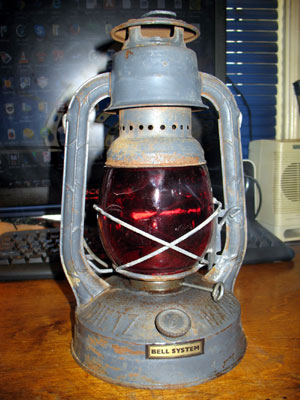 |
 |
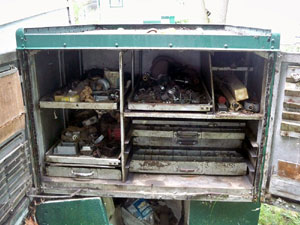 |
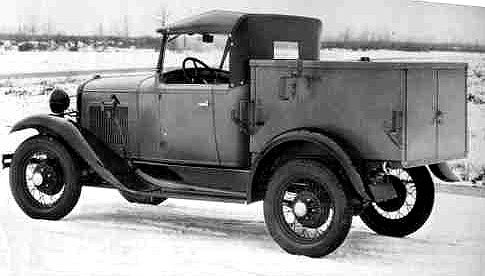
|
Controller and NE233QF shown below installed in the museum. This phone (right, above) is operating on the controller (left). Insert a dime or two nickels and you get dial tone. Dial a number and if the call goes unanswered, you coins return. If the call goes through, the coins are collected. Eventually, most of the pay phones in the museum will operate on this controller. Controller courtesy Stan Schreier.
Teletype Magnetic Service Vehicle Sign Also included are a Model 14 teletype, loop supply, 2 power supplies, boxes of Teletype parts, rolls of paper tape, ribbob, etc. etc.
This is unlike the test given by a BK or Radio Shack tester - they display one digit at a time. This tests to closer tolerance, and will display full numbers on its screen. It will also show the timing of a pulse dial. It will give the PPM on the left hand side of the screen, and the make-break ratio on the right. A great way to make sure a dial is within specs.
Sunday, at one of my identified hot spots, I got a number of items, all interesting.
The kit was made for replacing coils of NE-AF, NE-AG, NE-AJ, and NE-AK type relays. (line and cutoff type). A BSP for the use of this kit maybe found on the TCI document library, 040-272-801.
Internally, this collector and the earlier purchased Model 11 are quite similar. Both consist of a Gray lead coin chute which channeled the coins to the proper gong/bell. The Model 14 has a cage around the coin box, presumably as it is portable and as a result, there had to be a means of keeping the coins inside the box as the phone was moved. The Model 11 doesn't have this cage as it is used normally screwed in one place. The Model 11 doesn't have the drilled and tapped holes for the mounting of the side racket or the candlestick strut, for the top handle, or for the candlestick under-plate that the Model 14 has. On the other hand, the model 11 has its larger back-plate designed to be screwed to the wall behind the wooden wall phone it is paired with. Both are acoustically coupled to the phone. The operator would listen to the coin drops via sound transferred to the phone's transmitter acoustically though the brackets. The caller would call the operator as normal, and she would determine the rate, and ask them to insert the correct coinage. The Bell and gong inside the collector would allow her to ascertain that correct coinage for the rate had been inserted by the caller before putting them through. These are definitely cool devices, a big improvement over the so-called courtesy boxes used privately!
But the best thing today was an original Strowger 11 digit wall phone from AE's Chicago works, bought on eBay. It is in great shape and will make a wonderful display in the museum of the earliest dial phone in widespread use in North America. Previously, I had only a photo of one of these displayed. . The 11th (first) digit was used for Long Distance, later found unnecessary and incorporated along with the Operator digit. The digits ran top to bottom, first the Long Distance digit, then O-1. These phones are becoming very rare. This phone will soon be winging its way here from Saskatoon. Some of these phones were sold to farmers to use as an intercom betweek their house and barn after they were removed from active service. This has preserved many of them in Western Canada. Despite this, they are considered quite rare. Isn't she a beauty? I have been looking for one of these for a long time, but as they were never used here, they simply don't show up. These preceded the rotary dial.
All have been cleaned up, the Wilcoms have been checked out, as have the 211s, the Uniphone has been wired for private line and outfitted with a spade-modular cord. Love to hear from anyone with a manual for either the Wilcom or the Dumont test sets. Wilcom and Fairchild can no longer supply these manuals.
These had been promised a few months ago - Linda and I later unpacked many of them on the new display case to photograph. I took these photos later after a quick rest. Not all would fit on, but I have taken a photograph of the remaining pieces in the boxes. Most are Northern Electric, but there is one aqua blue WE 500 set in the bunch... In total, there are 24 in all, plus the great box of spares! The parts included a number of NOS dial plastics (haven't counted them but in the vicinity of a dozen), spare handsets, including one with volume control, receivers, transmitters, and a large number of NOS in the bag spade cords. The handsets include about a dozen NOS Harmony handsets in great colours. There were also three beige NOS Round dial plates for TT dials, and 3 NOS beige face mats for 2500's. Still a lot of sorting to do! Meanwhile, Dave continues to look out for more. My favorites - the aqua blue 500, green 500, the yellow 500 in the box in the last photo, and the two red 500's. The yellow 500s need new handset cords, but there are a couple of NOS yellow cords in the spares box. As of noon, May 25th, 2011 all if these phones have neen changed from party line wiring to private line wiring, repairs made where needed, stickers removed, and all have been thoroughly tested. The last one done was the white 500 in the second photo with the G6 (amplified) handset (which was disconnected in the photo). It was a fun and relaxing job done in several spells sitting at my desk in the museum. Thank you so much Dave! |
|||||||||||||||||||||||||||||||||||||||||||||||||||||||||||||||||||||||||||||||||||||||||||||||||||||||||||||||||||
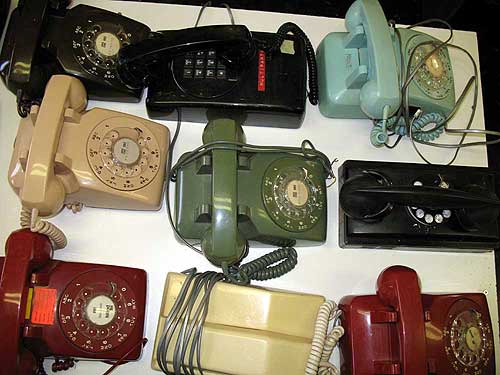 |
|||||||||||||||||||||||||||||||||||||||||||||||||||||||||||||||||||||||||||||||||||||||||||||||||||||||||||||||||||
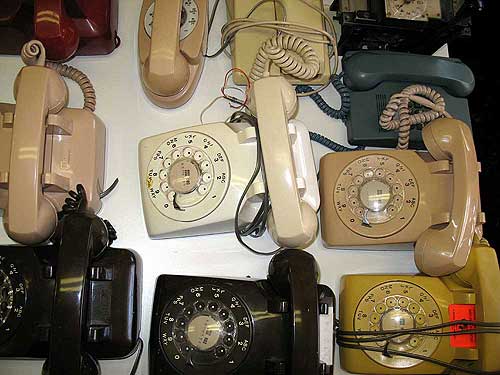 |
|||||||||||||||||||||||||||||||||||||||||||||||||||||||||||||||||||||||||||||||||||||||||||||||||||||||||||||||||||
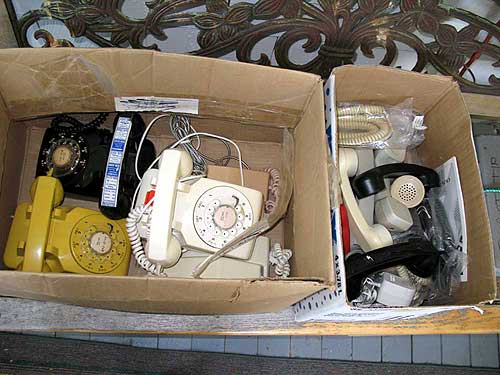 |
Items For Telegraph Display:

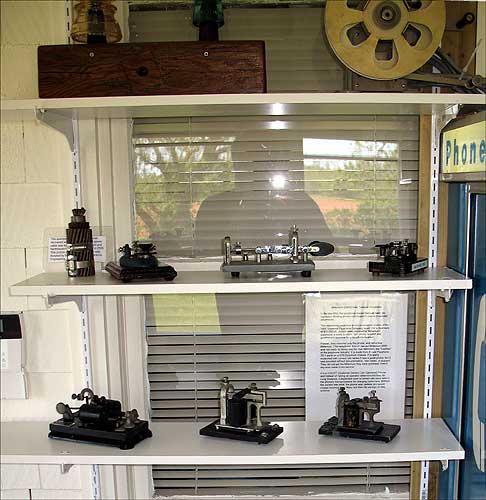
Start of the Museum's Telegraph Display
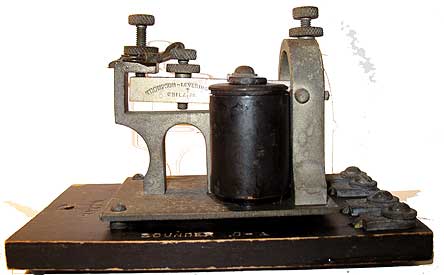 |
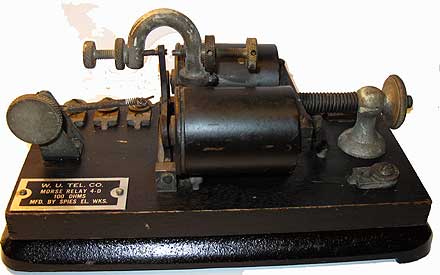 |
| These will be placed along with a Speed-X key in the museum's small collection of telegraph items. See below for details of the Wilson key being donated. These two will be left in their natural state. Brass and wood surfaces have been cleaned and polished but not overcleaned. The WU3A sounder has the uncommon silencer on the upper left which could be rotated out over the sounder bar to keep it from clicking. The 3A sounder was manufacured by Thompson Levering of Philadelphia, and the 4D relay by Spies Electrical Works of Chicago, both manufactured for and stamped Western Union..
A Western Electric 15-B 120 ohm main line sounder. It has an adjuster lever on the resonator plate which moves the coils in and out. The cross-bar and coil pole ends are oriented at an angle instead of being horizontal as in the above sounder. These work on the same principle. The line connects to the coils which pull their steel armature towards the electromagnetic pole when powered. The sounder design creates a clicking sound each time the voltage pulses on. The current is interrupted on and off by the key, powered by a battery supply in series with the line. Using American Morse or International Morse code, characters created by the key at one end of the line can be deciphered at the other end by the clicks of the sounder.
On the relay, when it's armature is pulled in, it acts as a switch which connects to another line, repeating what comes in on the first line. Therefore, the relay can be used as an amplifier of sorts, taking a weak signal from the incoming line, and repeating it to the outgoing line. The most noticeable difference is in the sound generated - The armature/sounding bar on the sounder is designed to make more noise so the operator can hear the signal, as compared to the quieter relay.
A WWII Wilson RCAF key is being donated by George Curtis in Kensington, here on the Island. This key was manufactured in Toronto during the war. it should be here the weekend of May 28. I have made a mahogany base for this key, and it will be included in the display.
Vibroplex, S/N 252634 ca. 1967
I have always thought these were beautiful and intriguing instruments, and back when I was a beginning Ham Radio operator, I would have loved to have one. Thank you, Robert! Vibroplex has been manufacturing keys since 1890. Telegraphy is worth mentioning in the context of the telephone, because much of the background for the telephone was provided by the earlier research and design work done on the telegraph. I would love to hear from anyone else with a telegraphic collection. Just click on my name where it is given at the bottom of this page..
Electro Bug Jr., S/N 1342, Electro Mfg. Co., San Francisco, ca. 1927-1934
In 1933, the company was bought by Stewart Johnson - the name changed to Speed-X in 1934. In 1937 Les Logan bought the company, and it changed hands again, ten years later - this time to E. F. Johnson in 1947, and finally in 1974 the brand became the property of the W. M. Nye Company where the ownership remains today. I have the Electro-Bug displayed alongside a much later (60's) Speed-X straight key. This bug brought up a lively discussion on a collector's list - the design of the dit screw/pendulum area differs from that of later models. Later models appear to have been changed to a hollow spring loaded dit screw, whereas this one has a solid dit screw, which meets a flexible reed mounted contact on the pendulum arm. When depressed, the contact on the pendulum arm will depress into the pendulum shaft, serving the same purpose, but in a different way. This key has only a 4 digit serial number, though those on the above mentioned list have keys with 5 digit numbers. As with all Electro-Bugs, numbers are hand stamped and out of line. There are no other digits on this one (even lightly imprinted, an advantage of seeing it with, then without paint - I can be certain), which may indicate a very early production model - quite likely, considering its different dit screw/pendulum design! Originally I had difficulty even locating a serial number on it - it was obscured by so many layers of paint, and I was looking for it on top, and not the bottom. If you have one, with the bug laying on its back, paddles to the left, the number is located adjacent to the front right foot. I don't suggest anyone strip the paint off to read it - this was done by accident during the cleaning process, but looking at it with a flashlight shining from different angles may give you a pretty good idea of what the number is, even through multiple layers of paint. My initial guess as to what the number was was borne out when I cleaned it and destroyed the original coats of paint:-) |

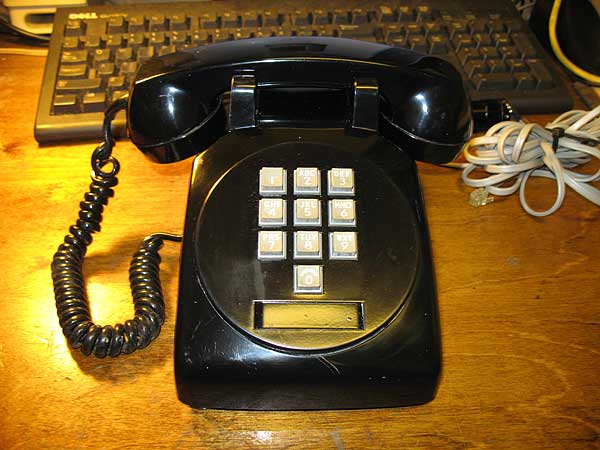 |
Now, I confess - this is a Frankenphone of sorts, though genuine in style and parts. All parts match in year, and were in the genuine 1500's. The body is a 500 c/d dated 1965, the dial surround and 1965 dial replace the original dial. I intend to overstamp the date on the base to reflect the fact it is now a 1500 (just add a 1 with my Neuses stamp set.) The scratches and paint specks showing in the photo were buffed out a few hours after this photo was taken, and it looks truly great! There should be a law against painting in the same room as a classic telephone. From the look of these, they were paint specks from the use of a paint roller nearby. I got the dial surround/mount from OPW and using Krylon, repainted it from its oridinal white, and the TT dial from Vern. Smudge on dial surround is only a little bit of Novus polish I missed wiping off. So, although a frankenphone of sorts, this phone it made from genuine parts, and was really manufactured. Western Electric made these phones, too, but used a case like the later NE 12 digit ones from the start. In the US, only the first prototypes were produced using these dial plates - but in Canada production of these lasted some 4 years before the 12 digit phones and new cases were introduced... A number card window has been ordered for this phone. This one will be on display in the museum until I can find a genuine 1500 at an affordable price, then will be converted back to a 500 c/d |
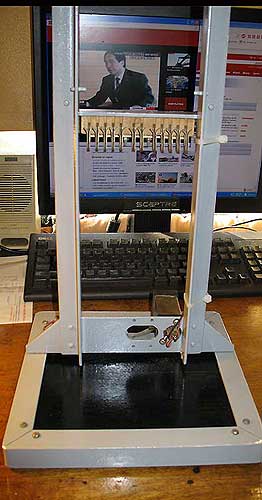 |
 |
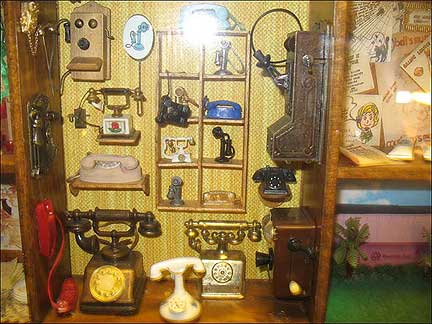 |
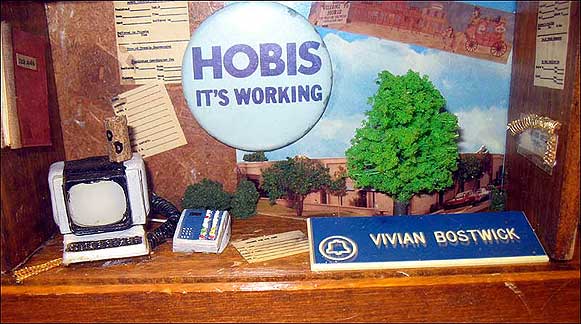 |
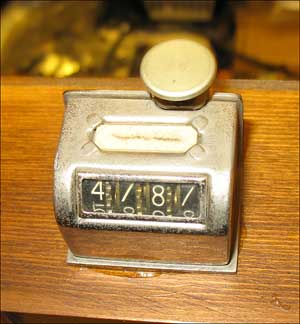 |
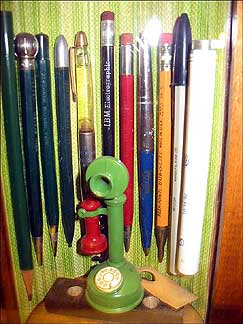 |
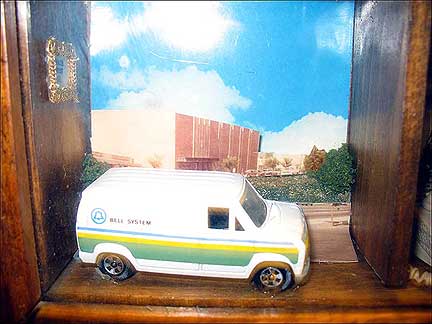 |
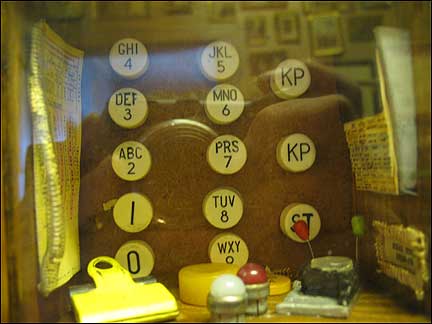 |
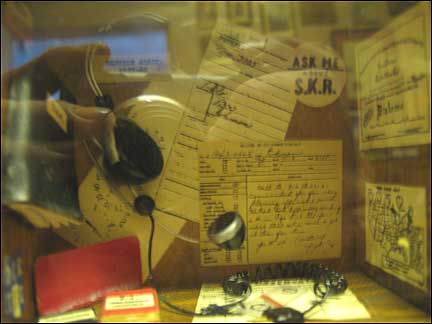 |
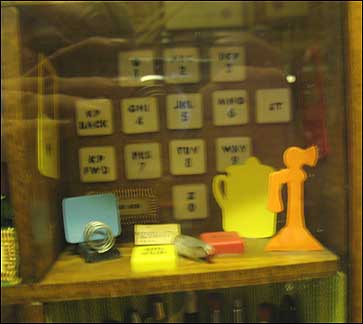 |
 |
This came many years ago from a test position in Charlottetown. The chair has been cleaned and lubricated, taking years of grime and paint off it and its upholstery, and after ArmorAll 'ing of the upholstery, ready for Jeffery to take over to the museum. Thank you, Leo! |
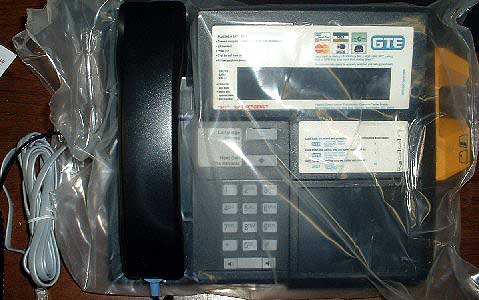 |
Experimentation on the first type shows the black and yellow are the power input pair. Power was applied using a Motorola POE supply (minus its POE connector) giving 24 VDC at .5 amp. When the polarity is correct, it clicks, then boots up to the default message, "Out of Service" as it should. On the second type, the power input will go to the second pair on the connector. I am looking for a programming or key interlock card for these phones. As these phones are credit only, and don't have a key, the key card is used in the programming process where is asks you to unlock the phone. Even with it, I won't be able to give demonstrations with it, as Millenniums need a connection to the Millennium Manager at Quortech. Programming won't be discussed - It is important to keep advanced information off the net to preserve the security of these phones. Jaqnuary 9th, I got into the craft level interface, but will require the card to get further into its programming. |
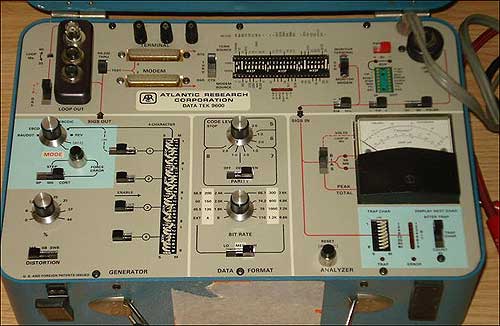 |
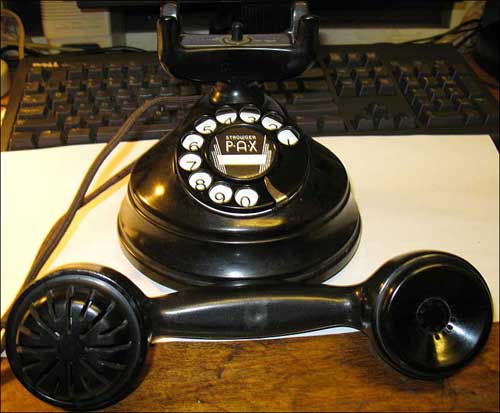 |
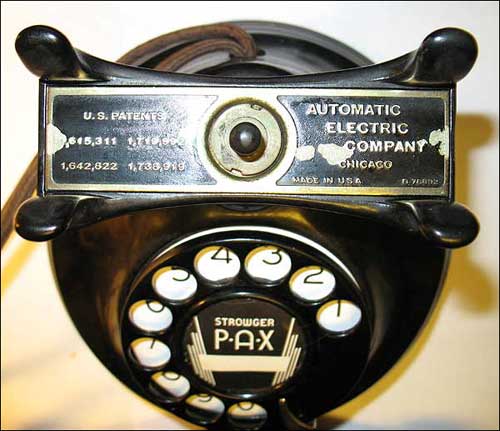 |
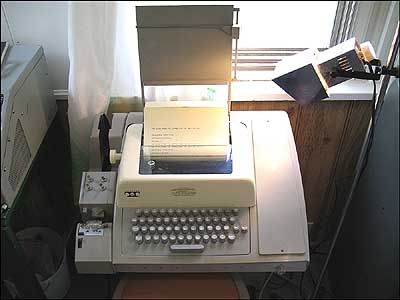 |
The teletype is in very good condition, though a couple of problems have been found in it since, it is a very clean museum quality piece and is operational now. The top cover was missing its plexiglass, and though the missing pane was there, I decided to mount a brand new Teletype cover I had here on it. In addition to the machine, Catherine also brought some much needed teletype paper. Catherine planned her vacation around the teletype this year. She has always wanted to visit Cavendish, and decided this was the year to kill two birds with one stone. Catherine also suprised me with a box of 9 rolls of much needed paper rolls for it.
Aug 02, 2010 - This machine has been set up using a Telebyte M65A converter to allow communication and feeds to and from the museum computer. I still require DB-25 Female to DB-9 Female serial port adapter on order to connect it to the computer, but external loop is now being provided by it. I picked up this converter last fall when I saw it on eBay for a good price. It is small and inobtrusive, and provides for the 20 ma. loop current needed by the ASR-33 without using a bulky external loop supply. It is perfect for interfacing an ASR-33. |
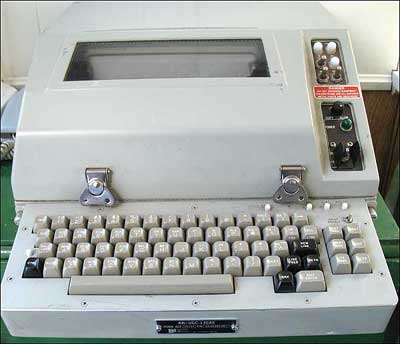 |
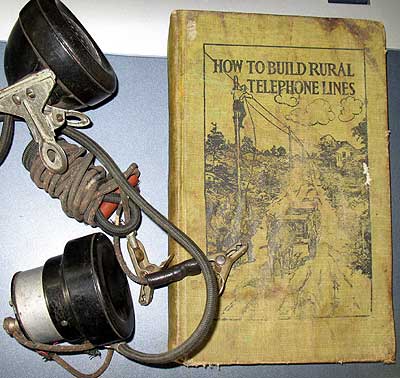 |
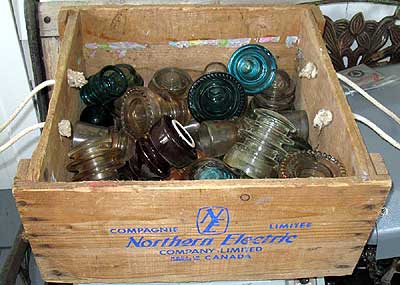 |
Open Wire Returns to Orwell Cove
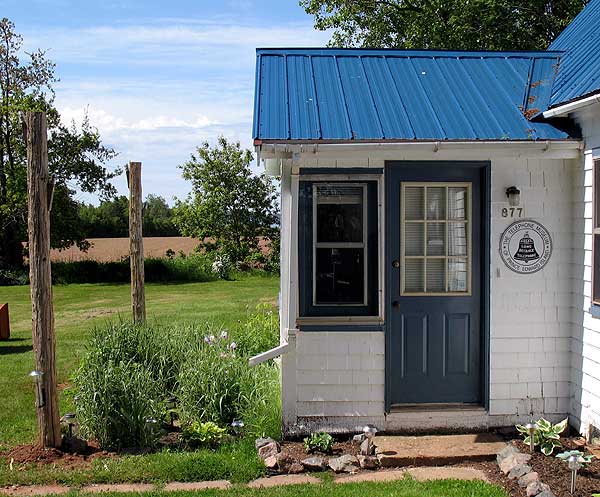 |
|
Teletype Model 28 ASR for the Teletype Display and Demo
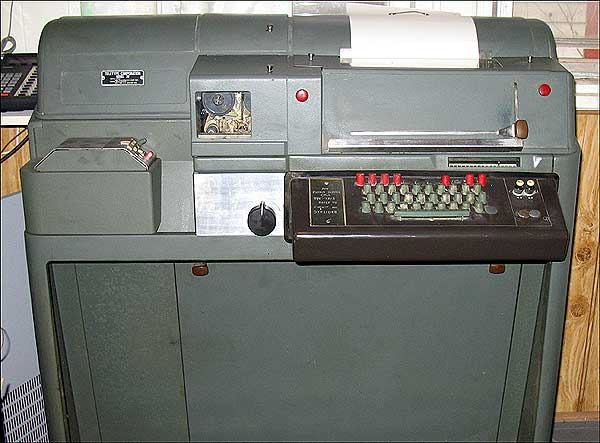 |
|
 |
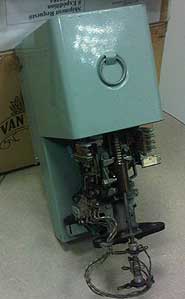 |
|
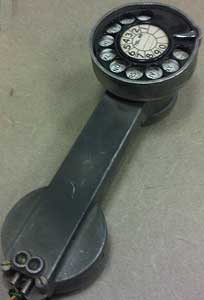 |
The above items were sent for the museum's displays by Gary Stoutenburg of Calgary. What a wonderful donation of items! The AEI 1st selector above is particularily significant, as the first automatic exchange on PEI was made by AEI and used these 1st selectors. That exchange was installed in 1950. A second similar exchange was later installed in Charlottetown. A photograph of the Summerside 1950 exchange is located in the museum. Gary at one point worked for AEI. Note: This is a so called "pre-2000" Strowger switch made in Britain. It is a "jacked in" first selector based upon the Seimens pre-2000 switch and made by AEI. Both GEC and AEI made similar switches - the AEI had a grey cover, while the GEC sported a red cover. Note the shorter cover than used on North American switches. Both exchanges have been gone now for many years, with many items scrapped, and others sent to Newfoundland for spares. I consider this find a wonderful stroke of luck, as it is the first switch I have found which was used on these long gone exchanges. Summerside 1950 Exchange - A photo of this historic exchange is located in the museum. Commemorative Plaque - In 1988 Summerside's step by step switching system replaced by a Nortel DMS-100, and commemorative plaques were issued to employees and suppliers. These plaques had a wiper from the original switches mounted on them. One of these plaques is located in the museum. Thank you so very much, Gary! |
|
Wire and Cable Display
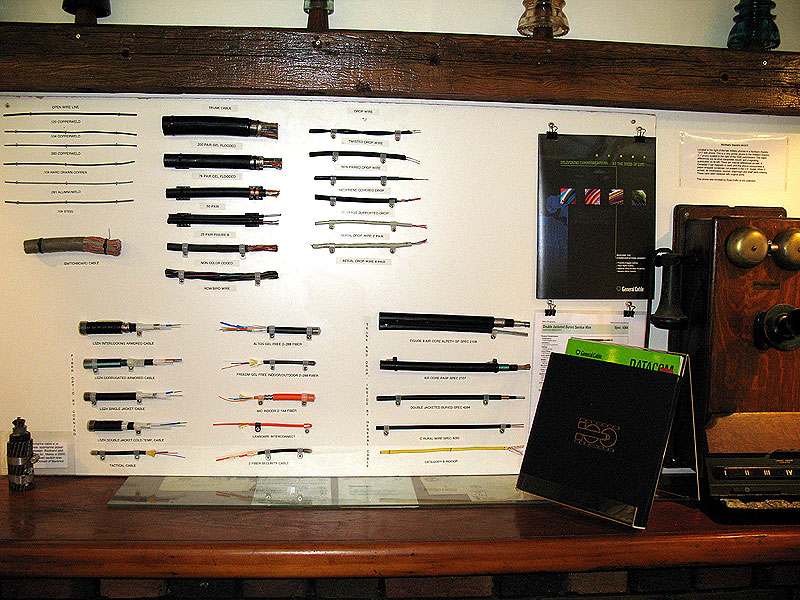 |
|
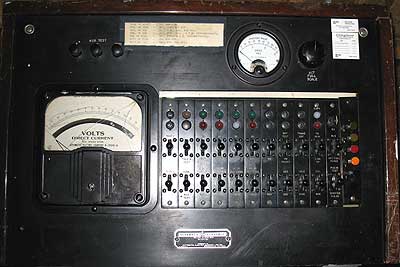 |
|
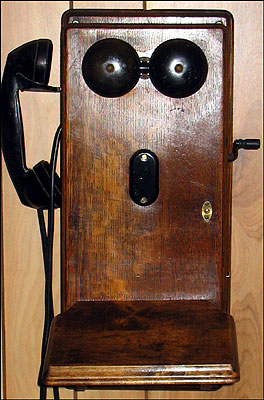 |
|
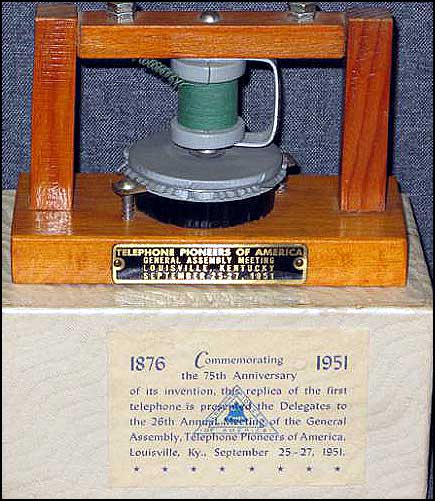 |
Bell Gallows Phone: August 11, 2009 - I won an eBay auction for a small relica of Bell's 1876 "Gallow Phone", so named due to the shape of its frame. This was the phone which won Bell his patent (U.S. Number 174,465) for sending speech over wires. It has been called the most valuable patent ever issued in the U.S.A. Although the gallows never did work terribly well (muffled and noisy audio), it did work sufficiently to win him the title of the inventor of the telephone. His patent was issued just hours before that of Elisha Gray for a similar device. This particular replica was made for delegates to the 1951 annual meeting of the General Assembly of the Telephone Pioneers of America held in Louisville, Kentucky September 25-27, 1951. It will receive an honoured spot directly under my earliest phone, the 1890 Bell Canada 3 box, Blake transmitter phone in the museum. |
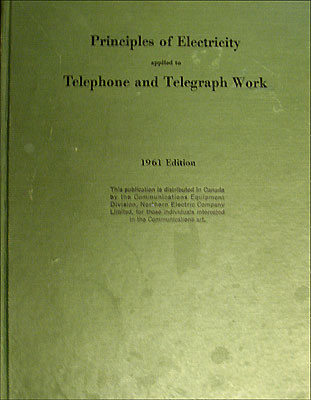
|
|
"Principles of Electric Applied to Telephone and Telegraph Work"
October 02, 2008 - I received a call from Eleanor Meek, who gave a number of phones and documents to the museum last year. Both Eleanor and her late husband, Roger had worked for Island Tel. Eleanor told me she had found a book, "Principles of Electric Applied to Telephone and Telegraph Work". It is a training course text prepared for Employees of the Long line department of the American Telephone and Telegraph Company published in June 1961. This book was printed in hard cover in 1961 by the Communications Equipment Division of the Northern Electric Company Limited, "for those individuals interested in the Communications art". Thanks again, Eleanor! |
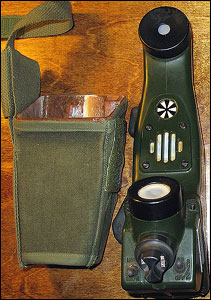
|
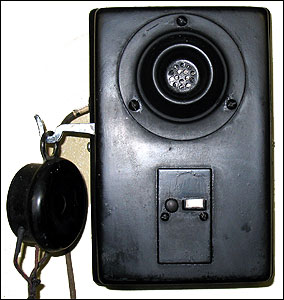
|
|
TA-5012/TTC
Sep 10 2008 - Tel.Set TA-5012/TTC, made by Marsland Eng., Ltd. Can. and marked Service Test Model ser. #9, Date 1966. It is powered by a 1 1/2 volt AA cell located under the fluted cover at the lower end. The large lever at the side spins a magneto within when depressed through a mechanical linkage. The PTT button is located above with a missed call indicator to its right. Two terminals for wired connections are located in a v-notch at the bottom. The switch on the lower right is labelled Buzz on/off and the left hand switch is labelled Norm/WSPR? It fits in the military green pouch provided. |
|
 |
May 06 2008 - 1972 Island Telephone Co. donated by Debbie Denham This is an interesting period on PEI, as larger exchanges were in the proccess of being automated, and smaller exchanges were preparing for automation within the following 5 years. As a result, both dial and magneto listings can be found in this book, depending upon which exchange a number is located within. |
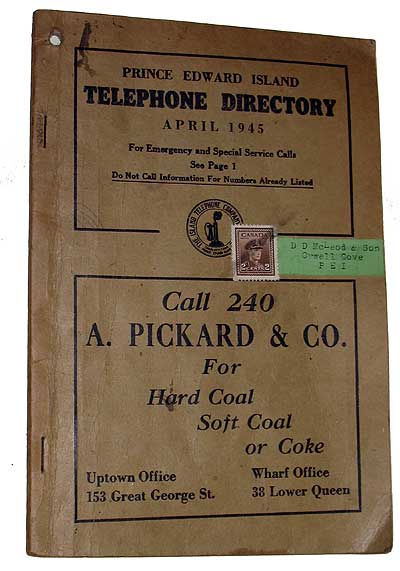 |
Prince Edward Island Telephone Directory, April 1945. January 13, 2008 - Here is a gem received this week. I received a call this afternoon from the widow of a neighbour who passed away last week. She had a 1945 Island Telephone Company book that they had been meaning to give me for some time.... Her departed husband, Clifford McLeod was the son of D. D. McLeod, who ran a store here in the Cove for the early part of the century, and which contained the only phone in the Cove up till the early 60's. The mailing label and stamp (all 2 cents worth) are still on its cover (the mailing label was a wrap around affair which held the book closed during mailing...) |
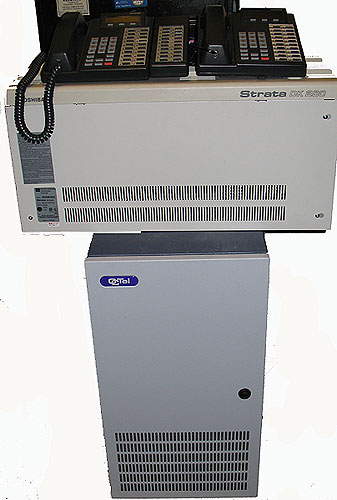
|
Toshiba Strata DK280 This is a Toshiba DK280 Digital KSU, phones, and an Octel 200 Message server picked up for the museum this week. The KSU (top) is equipped 8 loop lines, 16 digital phones, 16 analog phones and 8 dtmf receivers. The CPU is a large system processor, release 3 or 4 and it has a PIOU card for admin, smdr and paging. The Octel 200 is a very capable scaleable voicemail and fax server which was used with this machine in its original installation in a downtown Charlottetown office. Along with the system came 14 phones designed for use with the system for display. Our thanks goes out to Kevin Doyle and Sun Life for donating this system. The system would be about ten years old. It had been removed from service when a new system was installed, and was taking up space in their offices. They were pleased to know it would be of some use, and I was glad to see it kept out of the dump! This system has been set up in the museum entrance-way for demonstrations. The voicemail has not yet been installed, but the system is currently operational with 3 digital sets.. |
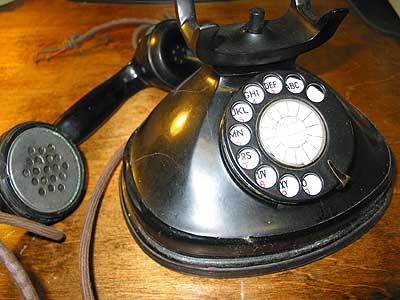
|
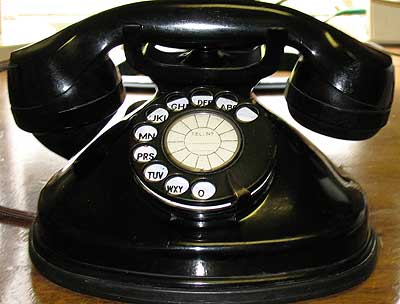
|
|
|
Most recently, a Nortel Cap unit has been received. CAP and KIM are busy lamp fields by default but have the ability to have lines put on them as well. A CAP has to be connected to a 7324 Norstar phone. The line cord comes to the CAP and then a short cord from the CAP to the phone. Multiple CAPs can be used on a phone as well. Terry Biddlecombe tells me you can program pretty much any function onto it that could go on the phone. On a 6-16 you probably can't put lines on the CAP but feature keys, internal extensions with busy indication and one button calling or external autodials etc. I will have to find a power supply to provide 24vdc to it, and then will use it on the office phone in the museum to display the status of the other Norstar phones in the museum. This unit is in NOS (new old stock) condition.

May 11th, copies of the T7, T9 Northern Electric Catalogues and a Northern Telecom Product handbook were purchased to add to the collection. The T-7 catalogue was issued in 1947, and the T-9 catalogue, issued in an updateable binder, issued first in 1962. It differed from the T-7 and T-8 catalogues in that replacement pages and change notices were sent out to keep the issue current. As a result, there are no two T-9 catalogues exactly the same, as it was up to the customers to add/remove pages to keep them current. This T-9 binder is not complete, missing some pages, and the missing pages have been supplemented by pages reprinted from my CD rom copy of the catalogue. Also found was a Northern Telecom Product Handbook - Internal Use Fourth Edition June 1981, described as in very nice condition, hard cover, 216 Pages, Some of the index: Telecommunications, Terminals, Electronic Office Systems, Cable, outside plant products, Business Communications and networks, Central Office Switching, Transmission Systems and Equipment, Network Support and Test Systems, Repair and overhaul Telephone Sets. This is a manual which I hadn't previously seen. I also have PDF copies of the T-3, T-6, T-7, T-8 and T-9 catalogues also on CD for daily reference (see the note about Fred Coady's catalogue scans at the bottom of the Links page).
A brand new copy of the T7 catalogue has been found. This catalogue has been sitting in a box full of unused/unsent T7's in their unopened mailing envelopes. The one shown below will be the issue that will be used, and the NOS catalogue kept as a spare.
 |

|
 |
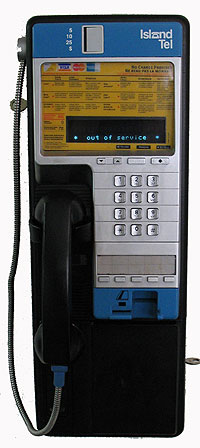 |
Nevada Bell Nortel Millenium Shown to the left is a Nortel Millenium Payphone received mid-June. This phone was surplus from Nevada Bell. Because of the Millenium's need to "call home" to a Millenium manager, I won't be able to get too much on this phone working, and it won't be able to be connected to a phone line, but it will make a great display piece. It is an early Millenium, made around 1993 or perhaps a little later. It contains the first revision of boards and eerom. The Millenium is a common site today on the Island, and indeed in much of Canada and the U.S. This is a so-called BOCOT/COCOT- like "Smart Phone", featuring a digital instruction display, adjustable volume, options accepting credit and calling cards, coins of 5, 10, 25¢, and dollar. Originally developed by Northern Telecom (Nortel), and typical phones of the series carry the designation, NT5U411BA2011 R11(Just an example of the numbering from a Millenium shipping box I have). Loved by operating companies, and despised by phone phreaks (telephone hackers), the Millenium series are the most advanced payphones in the world. The Millenium is the most secure payphone on the market and to keep it that way, information on the phone is very hard to find. Only details which are publicly available on the phone will be noted here. Millenium phones call daily to their "hive" and contain internal alarms to monitor activity on the phone. Dial tone heard when the handset is raised is computer generated, and the rate tables are contained within the phone and programmed and updated by the Millenium manager. A scrolling advertising line on the phones may also be programmed via the Millenium Manager to show up to 20 advertisements on the display's second line. The Manager can provide constant checks of the phone right down to the number and denominations of coins in the box, credit card verification, self-diagnostics, logging of operational notes such as cleaning and delivery directory dates, and detailed call activity statistics which may be used for planning. The Millenium is available with or without a smart card reader or a multicard reader option allowing users to use magnetic stripe commercial credit cards, calling cards and smart cards / chip cards, and with an optional jack which allow users with portable computers to connect through the phone. The options are seemingly endless A Island Tel bezel and instruction card has been obtained for it - a remnant of the Island Tel - Aliant rebranding a few years ago, and it will be upgraded to a yellow multi-card reader when I have the time. Along with the bezel, new Medeco locks were installed. All appears to be working as it should. |
| The following items were received June 29th 2007 from Eleanor Meek in addition to a number of useful manuals and photos as well as a lucite Operator's Service sign. Both Eleanor and her late husband, Roger had worked for Island Tel. One of the photos is a 70ish photo of a large group of Island Tel workers - most are identified, and this has been framed and located to the right and above the switchboard and magneto phone display. Thank you, Eleanor! |
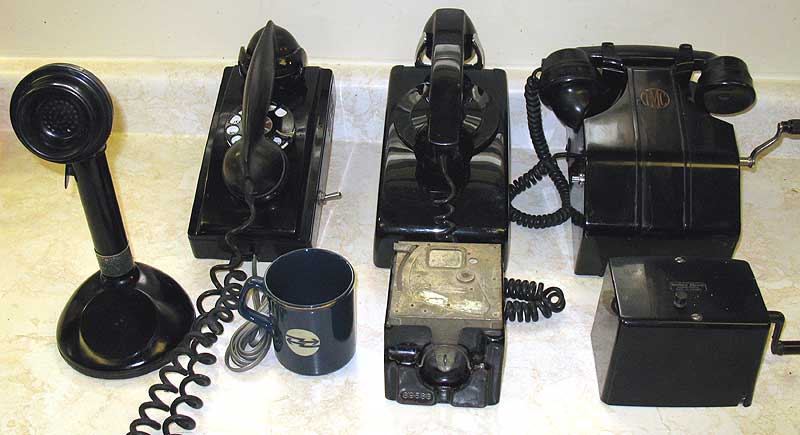
|
|
[Back Left] A Northern Electric 352 wallphone - the wall equivalent of a 302, the "I love Lucy" phone. The major work needed on this phone was to remove layers of paint from the back edges of the phone, where paint had inevitably gotten on the phone during many years of use and wall painting. [Back Middle] A Northern Electric dial-less 554. This could be used as a non dial extension phone or in conjunction with a magneto, as shown below, on magneto lines. This phone is just about mint. This phone and the QK82A magneto below have been mounted and connected on display in the museum. [Back Right] This is a wall magneto phone manufactured by England's Telephone Manufacturing Company. It required some repair to its case - a crack ran down much of the length of the phone - this has now been repaired, and though it shows a little, the case will not crack further. The phone is 100% operational. These phones were very popular in Manitoba - and apparently were also imported in some numbers here, though they are seldom seen. This phone is now on display in the museum. [Front Left] Beautiful Northern Electric Communications Division Candlestick microphone Model Number 1120DA - designed for use as a microphone. PTT switch on side. Rivets holding the bulldog microphone had failed, leaving the head dangling. These have been replaced as seen above. This was built as a microphone, and not just a converted candlestick phone. This is now displayed alongside the Northern Electric speaker driver and horn as examples of "other items" made by NE.. [Front second from Left] 60's vintage NB Tel coffee mug bearing the logo of the time. I also have a belt buckle with this logo. [Front second from Right] 3 slot coin box full of examples of slugs people had used in payphones in attempts to get free calls. These are items Roger had found in payphones over the years. These range from French coins, to tiddley winks, to drilled quarters attached to monofilament string (I guess so it can be recycled :-) to electrical box knock-outs, washers, hammered quarters, a test slug, and a Ureguay coin, TTC tokens, etc. This box and the slugs are now displayed with the payphones in the museum! [Front Right] NE QK82A 1967 Small square magneto in hard plastic case for use with stands. This is now displayed connected to the dial-less 554 in the museum, and turning its crank will ring the 554. |
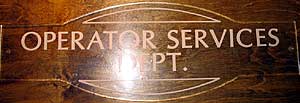 |
The sign to the left was brought by Eleanor, and has been mounted alongside the Tyne Valley 1240 switchboard and magneto phone display in the museum! |
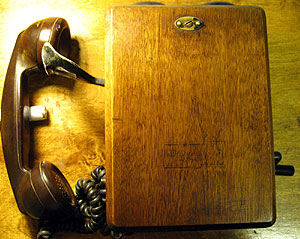 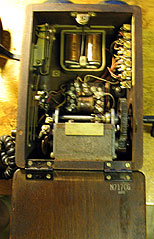 |
Aug 7th, 1007, I was called in the evening to see if I was interested in a farm fresh (untouched and original finish) N717CG at a good price. At first I balked, as I already have one, but finally decided I would take it. These phones saw a lot of use on PEI in the country. I remember one in use at the little store which used to be next to the schoolhouse up at the corner. My next door neighbours also had one. They saw service until the 60's when the area switched to dial service. |
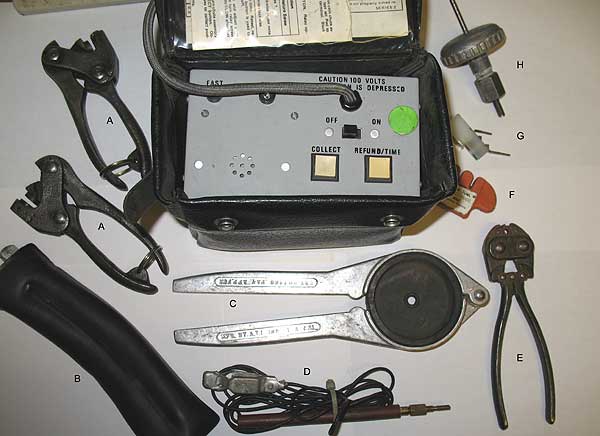
|
New Tools Received Aug 17, 2007: A). United Seal Company HC7 lead seal hand presses- used to
install lead seals on payphone money boxes to prevent tampering. Finally, a Western Electric KS-21250 L1 Coin Crafts Test Set - Checks payphone coin relay, sidetone, Refund/Collect Function, etc. Shown at centre top. |
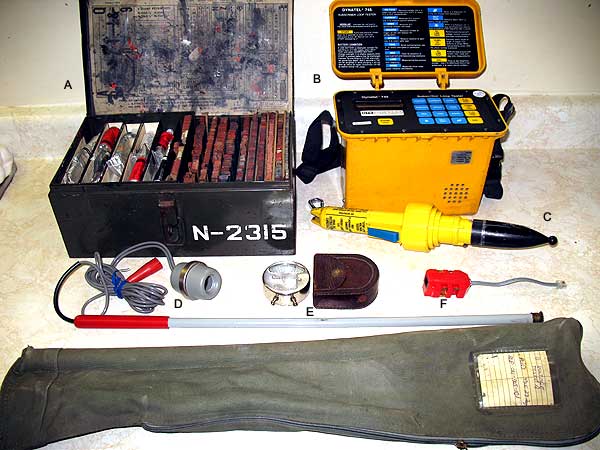
|
|
New October/September 2007: A) Neuses N-2315 stamping and lettering kit - used to stamp identifying marks and dates on switchboards, phones, etc. B) Dynatel 745 - microprocessor controlled Subscriber Loop Tester - Used to check the incoming loop for such things as loop voltage, current, opens, loss, Will measure the number and type of ringers on the line, will measure resistance, inject a test signal into the line, and more. C) "Stop Lite" Voltage Tester - Used to check for hazardous voltages on telephone equipment in contact with electrical lines. D. B Voltage Tester and case - used to check for dangerous voltages on shared poles. E) Connecticut Tel. and Elect. Co. Ltd. Pocket Volt/Ammeter from the early 30's or 40's. The company which made this was a manufacturer of telephones, intercoms, and of other electrical items. Despite its age, when it arrived, I decided to see if it worked, and voila, after many years of sitting in someone's sock drawer, it still worked! These meters were used to check the voltage of batteries used in local battery telephones, etc. F) "Banjo" 6 wire Modular adapter - for using a butt set or loop tester on modular lines. Gives a place for larger test leads to connect. |
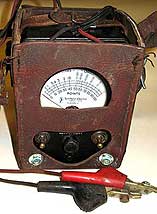 |
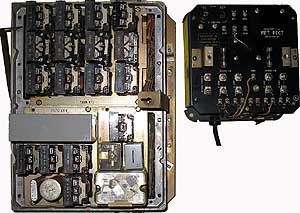
|
| New, September 22, 2007 - KS-8455L2 Bell System Line Loop Tester found for 50 cents at the 2007 70 Mile Coastal Yard Sale. | New, September 26, 2007 - Northern Electric 1A1 301Q1A KSU (Key Systems Unit) and power supply which were brought down to PEI by Don Ferguson. This is the older relay based system which preceeded the 1A2 KSU's like the QUJ9B. These are shown with the covers off. |
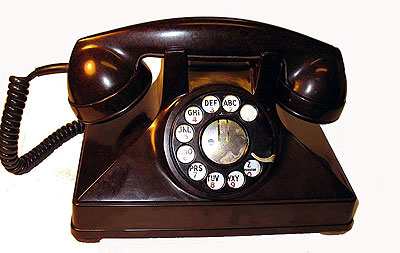 | Found at a yard sale, October 06, 2007. For some time I have been looking for a Uniphone in the rare burled walnut colour manufactured by Northern Electric. The closest I have come is an N717CG with a burled walnut handset. This Saturday, I didn't feel like going to many sales, but did go to one sale nearby. The sale was held in a fairly dark basement, and I failed to note that this phone was burled walnut. I almost didn't buy it as I have several #1 Uniphones, but decided at the last moment to buy it since they were only asking $10. As I took it out the door and the sun's rays fell upon it, I nearly dropped it, as I then could see it wasn't the usual black, but the quite rare burled walnut colour. As found, the phone was a dial-less #1 - I completed the conversion adding a dial. Dial-less number 1's differ from a number 5 in that they contain an inductor and condenser whereas the number 5's don't. This phone has not been buffed and won't be - its bakelite is in mint condition - why mess with perfection! This is quite a valuable phone compared to the run of the mill black Uniphone. |
As a diversion, I also collect cameras, mostly vintage. My favorites are vintage TLR's (twin lens reflex cameras), but this interest also extends to Brownie, Kodak, box, and folding cameras. This was a collection interrupted for many years by the collection of telephones, but recently I have gotten back into it in a small way. My fascination with cameras is similar to what I enjoy about telephones - it is the technology involved and watching the improvements in that technology through the years. I have recently placed a PDF listing of the cameras in my collection on the server. You can view it by clicking on camera_list.pdf